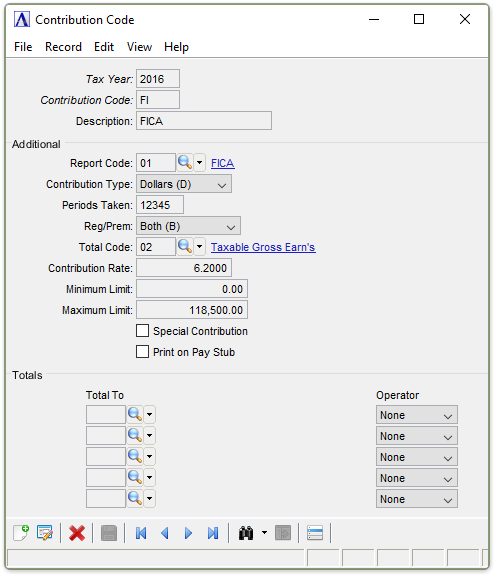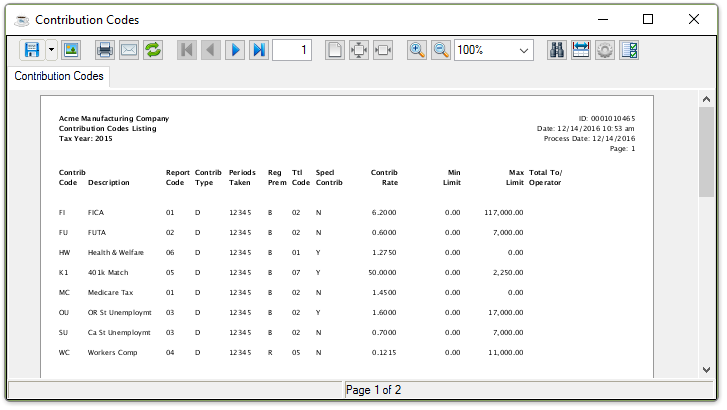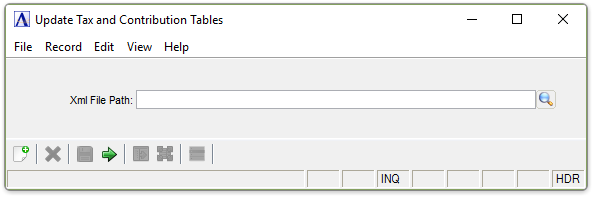Payroll - Contribution Codes
Function
The Contribution Code maintenance task defines and maintains employer contribution codes. Employer-paid taxes are based on employee earnings (e.g., employer’s FICA, state disability insurance, state unemployment taxes, worker’s compensation). Since these are employer-paid taxes, they are not normally printed on the employee’s pay check. is also available. The Display additional options... button provides a printed listing of all contribution codes.
=> To access this task...
Select Contribution Codes from the Inquiry and Maintenance menu.

Contribution Code
About the Fields
The Contribution Code Maintenance screen is divided into two sections. The upper section (header) fields are used to enter the contribution code and the description of that code. The lower section is used to enter the total codes to accumulate the contributions.
To Enable Edits to the form select  .
.
In the Tax Year field...
-
Enter the Calendar Tax Year that this Contribution Code Applies to.
-
Click
 to select from a list of all valid contribution codes.
to select from a list of all valid contribution codes. -
Click the record navigating buttons;
 to view the first record,
to view the first record,  to view the previous record,
to view the previous record,  to view the next record, and
to view the next record, and  to view the last record.
to view the last record.
In the Contribution Code field...
-
Enter a 2-character contribution code
In the Description field...
The description is displayed when this code is entered to define contribution codes in the Employee Masterfile Maintenance task.
-
Enter a description of up to 16 characters to identify the contribution code.
In the Report Code field...
This code specifies the column where these contributions are to be printed on the Payroll Contribution Report.
-
Enter a valid report code.
-
Click
 to select from a list of valid codes.
to select from a list of valid codes.
From the Contribution Type dropdown...
Enter one of the following to specify the calculation method used to calculate the amount of this contribution.
-
Select Fixed (F) to use a Fixed Dollar Amount for the Contribution.
-
Select Units (U) to use Total Units Worked (e.g., hours).
-
Select Dollars (D) to use Percentage of Dollars Earned.
-
Select None (N) to indicate No deduction type is required.
NOTE: When calculating contributions, the codes are processed alphabetically. If Contribution B is defined as some part of Contribution A, assuming A as least and Z as greatest, be sure the name of Contribution B is alphabetically later than the name of Contribution A. For example, if Pension Plan B is defined as 15% of the amount calculated for Pension Plan A, then Plan A’s code should be defined as PA and Plan B’s code should be defined as PB
or anything alphabetically greater than PA.
In the Periods Taken field...
When entering more than one payroll period, enter the numbers one after another, with no spaces separating entries (e.g., 12345 to select all pay periods 1 through 5).
-
Enter the payroll period(s) this contribution is to be taken, using the numbers 1, 2, 3, 4 and 5 to represent the payroll periods.
From the Reg/Prem dropdown...
Enter one of the following to specify the basis used to calculate the amount of this contribution.
-
Select Regular (R) when the contribution is taken on regular earnings only.
-
Select Premium (P) when the contribution is taken on premium earnings only.
-
Select Both (B) when the contribution is taken on both regular and premium earnings.
In the Total Code field...
This is the total to be used to calculate the contribution when you enter a ‘U’ or ‘D’ in the Contribution Type field.
-
Enter a valid total code as the basis of the contribution.
-
Click
 to select from a list of valid codes.
to select from a list of valid codes.
In the Contribution Rate field...
-
Enter the rate to be used to calculate the contribution when you select Dollars (D) or Units (U) in the Contribution Type field.'
-
Or enter the fixed dollar amount to be deducted each specified payroll period when you select Fixed (F) in the Contribution Type field.
In the Minimum Limit field...
During automatic payroll calculation, the employee year-to-date earnings are compared to this limit. When the total earnings are less than the Min Limit entered, no contribution is assessed.
-
Enter the minimum annual dollar amount that must be accumulated before the contribution is calculated.
In the Maximum Limit field...
-
Enter the maximum annual dollar amount on which this contribution is based.
-
Zero indicates that there is not a Maximum Limit.
During automatic payroll calculation, the employee year-to-date earnings are compared to this limit. When the total earnings exceed the Max Limit entered, no further contributions are assessed. If the Max Limit or Contribution Rate changes during the year, the month-to-date, quarterly and year-to-date will be affected. It is recommended that a new contribution code be created in cases where the limit changed during the calendar year. Also, if the Max Limit has decreased during a calendar year, it is recommended that you check for negative amounts on the PRD/Payroll Detail Report and make the necessary adjustment to the PRD Payroll Entry task to prevent any errors from occurring, such as erroneous contribution refunds.
Special Contribution checkbox...
All contributions not checked in this field are automatically assigned to each new employee when defined in the Employee Masterfile Maintenance task.
-
Mark the box when this contribution applies only to certain employees.
-
Unmark the box if this contribution applies to all employees.
Print on Pay Stub checkbox...
Certain types of contributions may have reporting requirements notifying the employee of contributions made, along with year to date contributions.
-
Mark the box when this contribution should be listed on the employee's pay stub.
-
Unmark the box if it is not to be listed on the employee's pay stub.
In the Total To fields...
-
Enter a valid total code.
-
Click
 to select from a list of valid codes.
to select from a list of valid codes.
This field is only used in special situations such as accruals that are a percentage of this contribution. The code determines where the contribution is accumulated during calculation of payroll taxes, contributions, and accruals. Up to 5 Total To locations can be entered for each contribution code.
From the Operator dropdown...
-
Select Plus (+) when this contribution is to be added into the total specified above.
-
Select Minus (-) when the contribution is to be subtracted from the total specified above.
-
Select None when the contribution is to be neither added or subtracted from the total specified above.
When finished entering Contribution Code Information...
-
Click
 to save the record.
to save the record. -
Click
 to clear the form and begin again.
to clear the form and begin again. -
Click
 to delete the record selected.
to delete the record selected.
If the Window is closed without saving the record, the module issues this confirmation prompt:

-
Click [Yes] to save the changes.
-
Click [No] to return to the Payroll Maintenance Menu without saving the record.
-
Click [Cancel] to return the Contribution Code you are Editing.
Selecting the [Display additional options...] button  presents the choice to print a listing of all Tax Codes and the Table Update task.
presents the choice to print a listing of all Tax Codes and the Table Update task.

Selecting Code Listing creates a listing report:

Sample Contribution Code Listing
See Output Options
Selecting Table Update issues the following window:

Update Tax and Contribution Tables
-
Type in the file that contains the Tax Table Updates for the year.
-
Click
 to browse for the file.
to browse for the file.
When done making selections...
-
Click the
 to process the file.
to process the file.
The Tax Codes, Tax Tables, and Contribution Codes are updated with the new data.
Note: Data Contained in the Upload File will Replace existing Data in those tables if encountered!
______________________________________________________________________________________
Copyright BASIS International Ltd. AddonSoftware® and Barista® Application Framework are registered trademarks.